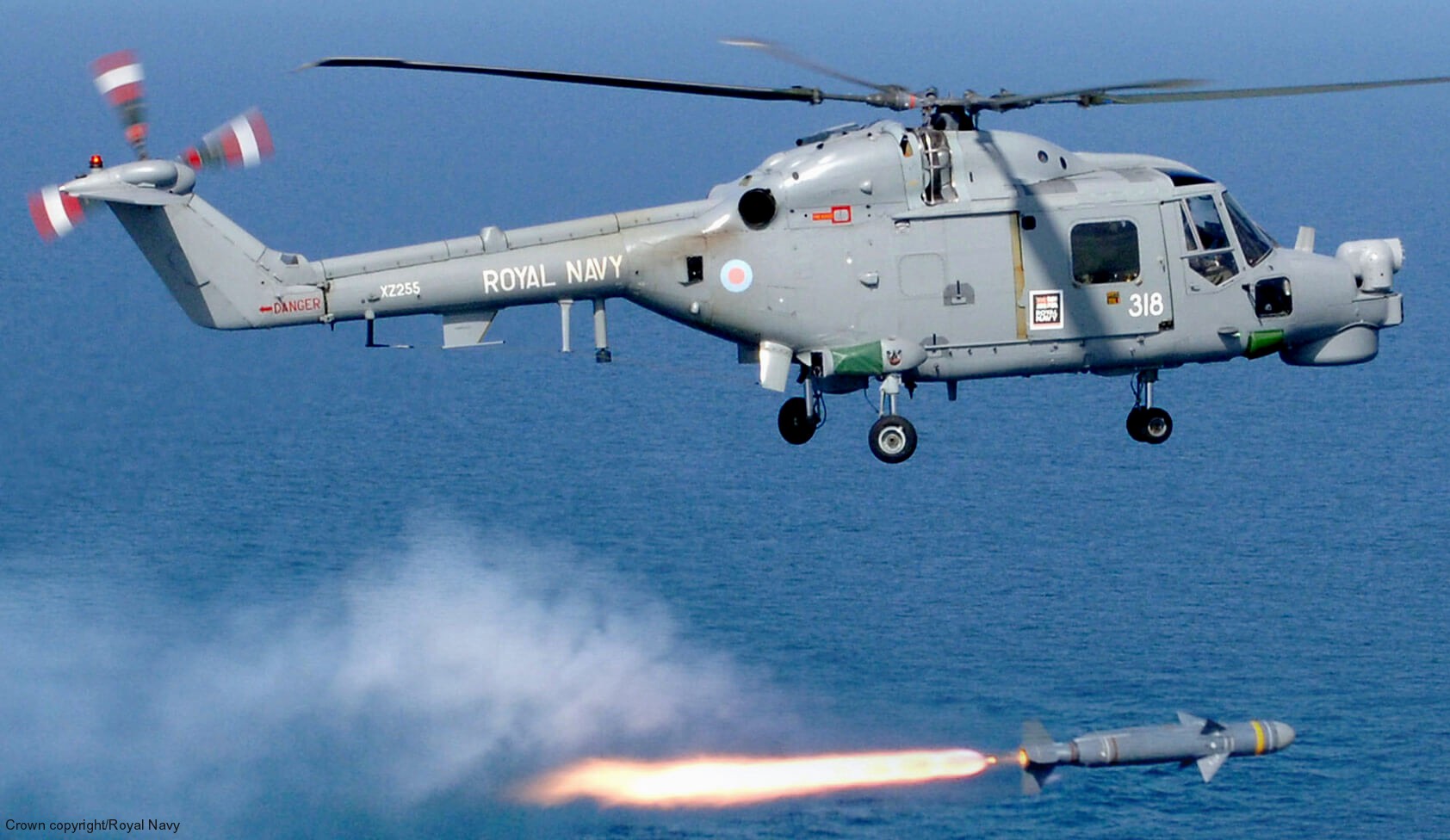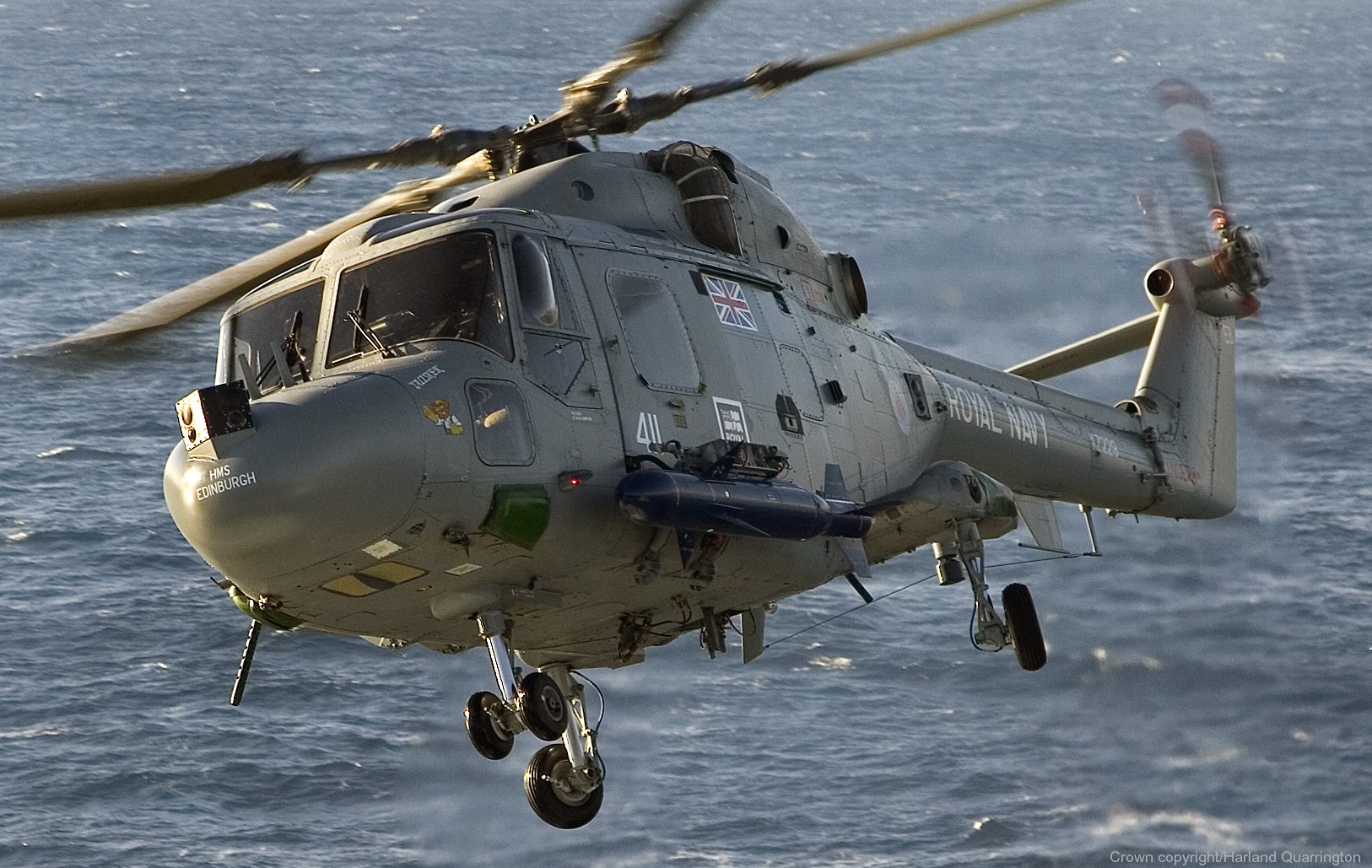 |
|
HOME
|
US Navy -
ships
|
US Navy - air
units
|
USMC - air
units
|
International
Navies
|
Weapon Systems
|
Special Reports |
|
Aircraft Weapon System Sea Skua Anti-Ship Missile |
 |
| 11/25 |
|
The Sea Skua is a British lightweight
short-range air-to-surface missile (ASM) designed for use from
helicopters against ships. It was primarily used by the
Royal Navy
on the Westland Lynx. The Royal Navy withdrew the missile from
active service in 2017. Although the missile is intended for
helicopter use, Kuwait employs it in a shore battery and on their
Umm Al Maradem (Combattante BR-42) fast attack craft. Development: Sea Skua ultimately traces its history to the immediate post-war era. Growing increasingly concerned about the threat of aircraft, especially after the introduction of glide bombs during the war, the Royal Navy had long been convinced that all ships required some form of surface-to-air missile (SAM). These systems tended to be relatively large, especially in the era before vertical launch, and it was difficult to mount both a useful SAM and a conventional gun on smaller ships. A gun was considered vital as the Navy's mission changed from one focused entirely on combat with the Soviet Union to the projection of power worldwide. This led to a series of experiments to produce a dual-use missile capable of both anti-air and anti-ship use. The original Navy guided missile sets, Seaslug and Seacat, both had secondary anti-shipping roles. Seaslug was a large system and could only be carried by larger ships, while Seacat could be fit to almost any ship but had a relatively short range and small warhead. Neither filled the goal of replacing guns. In October 1960 the Navy launched a project with the goal of producing a single weapon that could fit on a 3,000 ton frigate and able to attack bombers, anti-shipping missiles, and other ships up to frigate size. This led to the Small-Ship Guided Weapon and ultimately to Sea Dart. This system also proved too large for the smallest ships and the need remained unfilled. The sinking of the Eliat in 1967 led to the realization that small fast-attack boats were a serious immediate threat. A weapon was needed that could destroy any such craft before it could approach within the launching range of its missiles. Seacat did not have anywhere near the required range, Sea Dart did, but could not be fit to the majority of RN ships. A new conventional missile might be dedicated to the role, but it would have to be roughly the same size as those being aimed against it, which would take up too much room on a ship carrying many other weapons systems. Giving up on the original idea of having a dual-purpose weapon, the entire concept was reevaluated and led to the decision to launch the weapon from helicopters. This would allow a small weapon to have both the required range and warhead size. The missile would be carried by the new Westland Lynx and its targets detected by their Seaspray radar. Long range was not required, it only needed to be enough to keep the helicopter out of range of any anti-aircraft weapons the boats might carry. Its combat effectiveness was further improved by the addition of the Racal "Orange Crop" ECM suite, which allowed the helicopter to track the boats who were using radar to attempt to approach the ships, allowing the helicopters to approach without turning on their Seaspray until the last moment. The British Aircraft Corporation (BAC) began development in May 1972. The British Government authorised its production in October 1975. At the time, the missile was known as CL.834. The first launches took place n November 1979 at the Aberporth Range in Cardigan Bay. Three missiles were launched from the ground and three by helicopters. Further tests were made and in July 1981, full-scale production was ordered of the new missile, now called "Sea Skua". Design: With the missile weighing only 320 pounds (150 kg) at launch, a Lynx helicopter can carry up to four, two on each wing pylon. The booster is a Royal Ordnance (now Roxel UK) "Redstart" steel body, while the sustainer is a Royal Ordnance "Matapan" light alloy body. The missile flies at high subsonic speed to a range of up to 15.5 miles (24.9 km). The official range is declared to be 15 km, but this is widely exceeded. The missile has two sensors: a semi-active radar homing system by Marconi Defence Systems, and a Thomson-TRT AHV-7 radar altimeter (which is also used by the Exocet missile), built under licence by British Aerospace Defence Systems. It can be set to travel at one of four pre-selected heights, depending on the surface conditions. Near the target, the missile climbs to a height at which it can "acquire" the target. The launching helicopter illuminates the target with its radar (originally the specially developed Ferranti Seaspray in the case of the Lynx), and the missile's homing head homes in on the reflected energy. On impact it penetrates the hull of a ship before detonating the 62 pounds (28 kg) blast fragmentation warhead. A semi armour piercing (SAP) warhead is also available; this contains 9 kilograms (20 lb) of RDX, aluminium and wax. The fuze is an impact-delayed model. The illuminating radar aboard Lynx helicopters is the GEC-Ferranti Seaspray I band, which weighs 64 kilograms (141 lb), a power of 90 kW, two modes (three in the improved model) and a 90° observation field. The Seaspray Mk. 3 had a rotating antenna with a 360° field of view. It is capable of operating in a track while scan (TWS) mode. The missile flight ends after 75-125 seconds, during which time the helicopter can manoeuvre at up to 80° from the missile path. Service: In addition to serving with the United Kingdom, the Sea Skua has been exported to Germany (where it will be replaced from 2012 onwards), India, Kuwait, and Turkey. It was generally preferred to the similar rival, the French-built AS 15 TT, even though the two missiles had similar performance. The guidance of AS-15TT was radio-command, and it required the Agrion 15 radar, unlike the more flexible British missile. Sea Skua's success in active service and its adoption by the Royal Navy resulted in considerable success in the international market. Falklands War: Sea Skuas were launched eight times during the Falklands War, sometimes in extremely bad weather, and scoring a very high hit rate. Four were used against the 800 ton patrol boat/rescue tug ARA Alférez Sobral, fired by two Lynx helicopters from HMS Coventry and HMS Glasgow. Two struck the patrol boat on the bridge, one hit the ship's fibreglass sea boat, and one passed over the ship. Extensive damage was inflicted and eight crewmen (including the captain) were killed, but the ship was not sunk and returned to Puerto Deseado. Another four Sea Skuas were used to destroy the wrecks of the cargo ship Río Carcarañá (8,500 grt) and the patrol boat Río Iguazú. First Gulf War: During the Gulf War, six naval Lynx helicopters were deployed to the Gulf on four frigates and destroyers of the Royal Navy. On 24 January 1991 one Lynx engaged and sank two Iraqi minesweepers near Qurah Island. A third was scuttled. A larger engagement took place on 29 January 1991. A force of seventeen Iraqi landing craft and escorting fast attack craft and minesweepers was detected moving south near Failaka island, as part of the Iraqi attack which resulted in the Battle of Khafji. Two vessels were sunk by Sea Skuas fired by four Lynx helicopters. The remaining vessels were damaged, destroyed or dispersed by American carrier-based aircraft and Royal Navy Sea King helicopters. The next day, another convoy of three Polnocny class landing ship, three TNC-45 fast attack craft (taken over by Iraq from the Kuwaiti Navy) and a single T-43 minelayer, was detected in the same area. Sea Skuas fired from four Lynx helicopters destroyed the three fast attack craft, and damaged the minesweeper and one landing ship; the landing ship was later destroyed by RAF Jaguars. During several engagements in February, Lynxes with Sea Skuas destroyed a Zhuk class patrol boat, a salvage vessel and another Polnocny class landing ship, and damaged another Zhuk patrol boat. Sea Skua is planned to be replaced in UK service by the Sea Venom The Royal Navy conducted its final Sea Skua live firing in March 2017. Specifications: Type: Air-to-surface missile (ASM / AGM) Designer: British Aircraft Corporation Manufacturer: British Aircraft Corporation (1972-1977) BAe Dynamics (1977-1999) MBDA (UK) Ltd (since 1999) In service: 1982 Mass: 145 kg (320 lb) Length: 2.5 m (8.20 ft) Diameter: 0.25 m (9.84 in) Wingspan: 0.72 m (2.36 ft) Warhead: 30 kg (66 lb) SAP, 9 kg (20 lb) RDX Detonation mechanism: Impact Fuze, delayed detonation Engine: solid fuel booster / solid fuel sustainer Operational range: 25 km (46 NMI) Maximum speed: Mach 0.8+ Guidance system: semi-active radar homing source: wikipedia |
| images |
   a Royal Navy Lynx HMA.8 helicopter fires a Sea Skua anti-ship missile     Royal Navy Lynx HAS.3 helicopter armed with a Sea Skua missile      |
|
|
seaforces.org
|
Weapon Systems
start page
| |